谓语动词用单数复数的情况
- 格式:doc
- 大小:28.50 KB
- 文档页数:2
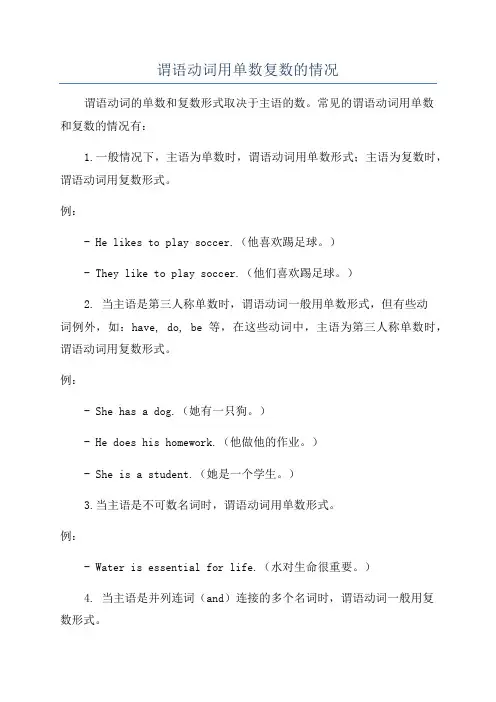
谓语动词用单数复数的情况谓语动词的单数和复数形式取决于主语的数。
常见的谓语动词用单数和复数的情况有:1.一般情况下,主语为单数时,谓语动词用单数形式;主语为复数时,谓语动词用复数形式。
例:- He likes to play soccer.(他喜欢踢足球。
)- They like to play soccer.(他们喜欢踢足球。
)2. 当主语是第三人称单数时,谓语动词一般用单数形式,但有些动词例外,如:have, do, be等,在这些动词中,主语为第三人称单数时,谓语动词用复数形式。
例:- She has a dog.(她有一只狗。
)- He does his homework.(他做他的作业。
)- She is a student.(她是一个学生。
)3.当主语是不可数名词时,谓语动词用单数形式。
例:- Water is essential for life.(水对生命很重要。
)4. 当主语是并列连词(and)连接的多个名词时,谓语动词一般用复数形式。
例:- Tom and Mary go to the movies together.(汤姆和玛丽一起去看电影。
)需要注意的是,有些名词看似复数形式,但在用作单数主语时,谓语动词仍然用单数形式,如:news, mathematics, physics等。
例:- The news is good.(这条消息很好。
)- Mathematics is my favorite subject.(数学是我最喜欢的科目。
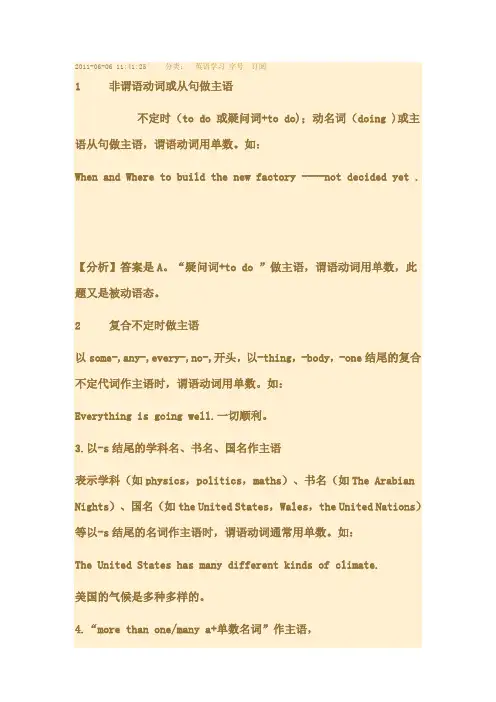
2011-06-06 11:41:25| 分类:英语学习|字号订阅1 非谓语动词或从句做主语不定时(to do 或疑问词+to do);动名词(doing )或主语从句做主语,谓语动词用单数。
如:When and Where to build the new factory ----not decided yet .【分析】答案是A。
“疑问词+to do ”做主语,谓语动词用单数,此题又是被动语态。
2 复合不定时做主语以some-,any-,every-,no-,开头,以-thing,-body,-one结尾的复合不定代词作主语时,谓语动词用单数。
如:Everything is going well.一切顺利。
3.以-s结尾的学科名、书名、国名作主语表示学科(如physics,politics,maths)、书名(如The Arabian Nights)、国名(如the United States,Wales,the United Nations)等以-s结尾的名词作主语时,谓语动词通常用单数。
如:The United States has many different kinds of climate.美国的气候是多种多样的。
4.“more than one/many a+单数名词”作主语,“more than one+单数名词”和“many a +单数名词”作主语时,谓语动词用单数。
如:More than one student has seen the film.不止一个学生看过这部电影。
Many a strong man has weakened before such a chal-lenge.许多坚强的人遇到这种困难都动摇了。
5.指同一个人或事物的并列结构作主语指同一个人或事物的A and B结构(如knife and fork 刀叉,bread and butter 黄油面包,a teacher and writer 老师兼作家,fish and chips 鱼和炸土豆片)作主语时,谓语动词用单数。
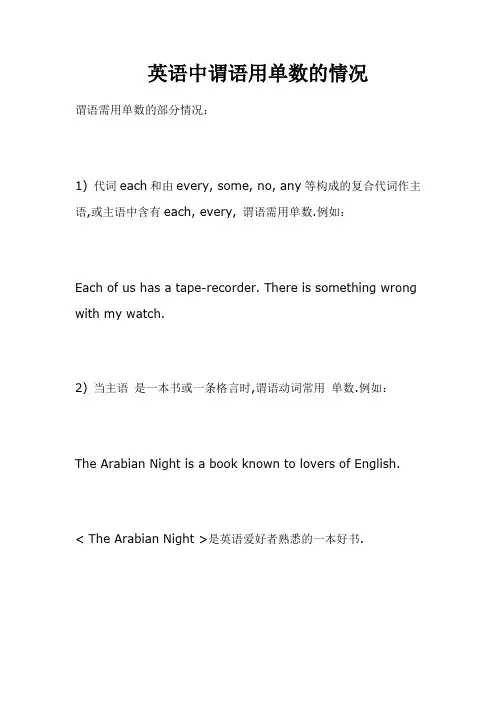
英语中谓语用单数的情况
谓语需用单数的部分情况:
1) 代词each和由every, some, no, any等构成的复合代词作主语,或主语中含有each, every, 谓语需用单数.例如:
Each of us has a tape-recorder. There is something wrong with my watch.
2) 当主语是一本书或一条格言时,谓语动词常用单数.例如:
The Arabian Night is a book known to lovers of English.
< The Arabian Night >是英语爱好者熟悉的一本好书.
3) 表示金钱,时间.距离.价格或度量衡的复合名词作主语时,通常把这些名词看作一个整体,谓语一般用单数.(用复数也可,意思不变.) 例如:
Three weeks was allowed for maki ng the necessary preparations. Ten yuan is enough.。
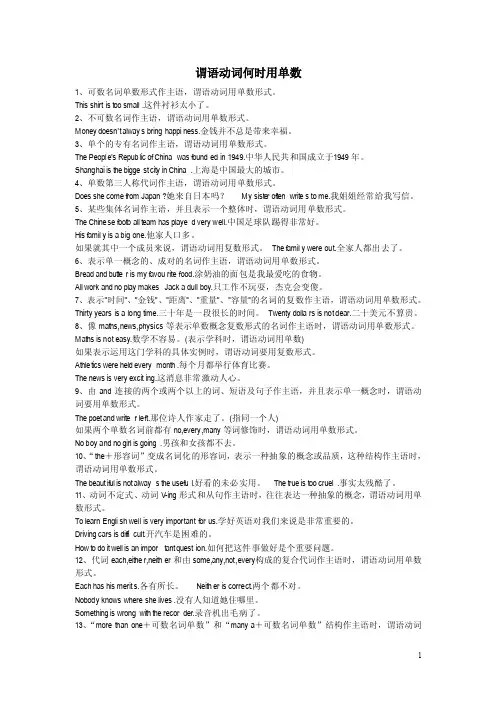
谓语动词何时用单数1、可数名词单数形式作主语,谓语动词用单数形式。
This shirtis too small.这件衬衫太小了。
2、不可数名词作主语,谓语动词用单数形式。
Moneydoesn't always bringhappin ess.金钱并不总是带来幸福。
3、单个的专有名词作主语,谓语动词用单数形式。
The People's Republ ic of Chinawas founde d in 1949.中华人民共和国成立于1949年。
Shangh ai is the bigges t city in China.上海是中国最大的城市。
4、单数第三人称代词作主语,谓语动词用单数形式。
Does she come from Japan?她来自日本吗?My sister oftenwrites to me.我姐姐经常给我写信。
5、某些集体名词作主语,并且表示一个整体时,谓语动词用单数形式。
The Chines e footba ll team has played very well.中国足球队踢得非常好。
His family is a big one.他家人口多。
如果就其中一个成员来说,谓语动词用复数形式。
The family were out.全家人都出去了。
6、表示单一概念的、成对的名词作主语,谓语动词用单数形式。
Breadand butter is my favour ite food.涂奶油的面包是我最爱吃的食物。
All work and no play makesJack a dull boy.只工作不玩耍,杰克会变傻。
7、表示"时间"、"金钱"、"距离"、"重量"、"容量"的名词的复数作主语,谓语动词用单数形式。
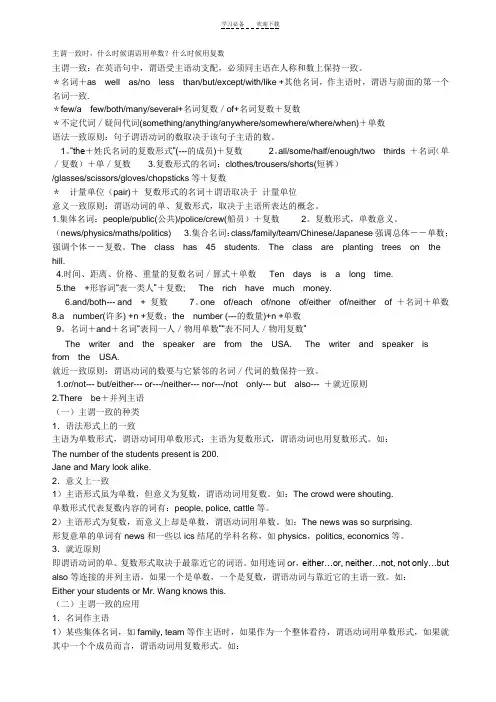
主谓一致时,什么时候谓语用单数?什么时候用复数主谓一致:在英语句中,谓语受主语动支配,必须同主语在人称和数上保持一致。
*名词+as well as/no less than/but/except/with/like +其他名词,作主语时,谓语与前面的第一个名词一致.*few/a few/both/many/several+名词复数/of+名词复数+复数*不定代词/疑问代词(something/anything/anywhere/somewhere/where/when)+单数语法一致原则:句子谓语动词的数取决于该句子主语的数。
1。
“the+姓氏名词的复数形式”(---的成员)+复数2。
all/some/half/enough/two thirds +名词(单/复数)+单/复数 3.复数形式的名词:clothes/trousers/shorts(短裤)/glasses/scissors/gloves/chopsticks等+复数*计量单位(pair)+复数形式的名词+谓语取决于计量单位意义一致原则:谓语动词的单、复数形式,取决于主语所表达的概念。
1.集体名词:people/public(公共)/police/crew(船员)+复数2。
复数形式,单数意义。
(news/physics/maths/politics) 3.集合名词:class/family/team/Chinese/Japanese强调总体--单数;强调个体--复数。
The class has 45 students. The class are planting trees on the hill.4.时间、距离、价格、重量的复数名词/算式+单数Ten days is a long time.5.the +形容词“表一类人”+复数; The rich have much money.6.and/both--- and + 复数7。
one of/each of/none of/either of/neither of +名词+单数8.a number(许多) +n +复数;the number (---的数量)+n +单数9。
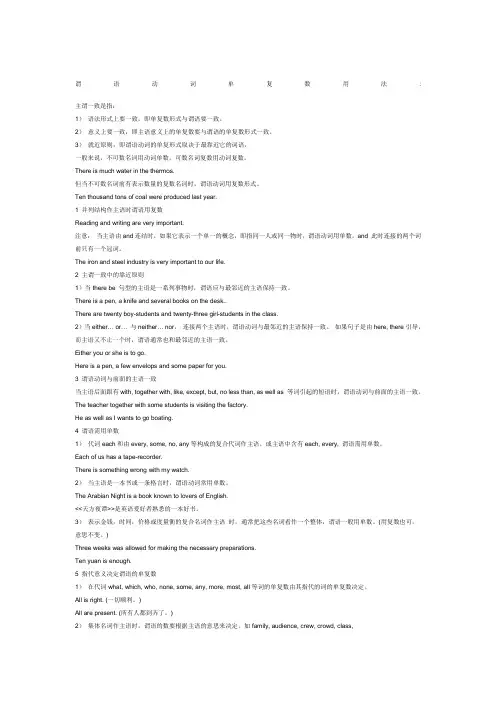
谓语动词单复数用法:主谓一致是指:1)语法形式上要一致,即单复数形式与谓语要一致。
2)意义上要一致,即主语意义上的单复数要与谓语的单复数形式一致。
3)就近原则,即谓语动词的单复形式取决于最靠近它的词语,一般来说,不可数名词用动词单数,可数名词复数用动词复数。
There is much water in the thermos.但当不可数名词前有表示数量的复数名词时,谓语动词用复数形式。
Ten thousand tons of coal were produced last year.1 并列结构作主语时谓语用复数Reading and writing are very important.注意:当主语由and连结时,如果它表示一个单一的概念,即指同一人或同一物时,谓语动词用单数,and 此时连接的两个词前只有一个冠词。
The iron and steel industry is very important to our life.2 主谓一致中的靠近原则1)当there be 句型的主语是一系列事物时,谓语应与最邻近的主语保持一致。
There is a pen, a knife and several books on the desk..There are twenty boy-students and twenty-three girl-students in the class.2)当either… or… 与neither… nor,连接两个主语时,谓语动词与最邻近的主语保持一致。
如果句子是由here, there引导,而主语又不止一个时,谓语通常也和最邻近的主语一致。
Either you or she is to go.Here is a pen, a few envelops and some paper for you.3 谓语动词与前面的主语一致当主语后面跟有with, together with, like, except, but, no less than, as well as 等词引起的短语时,谓语动词与前面的主语一致。
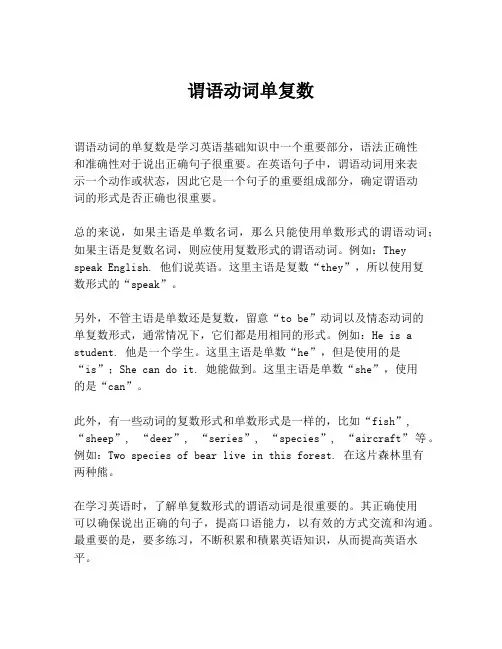
谓语动词单复数
谓语动词的单复数是学习英语基础知识中一个重要部分,语法正确性
和准确性对于说出正确句子很重要。
在英语句子中,谓语动词用来表
示一个动作或状态,因此它是一个句子的重要组成部分,确定谓语动
词的形式是否正确也很重要。
总的来说,如果主语是单数名词,那么只能使用单数形式的谓语动词;如果主语是复数名词,则应使用复数形式的谓语动词。
例如:They speak English. 他们说英语。
这里主语是复数“they”,所以使用复
数形式的“speak”。
另外,不管主语是单数还是复数,留意“to be”动词以及情态动词的
单复数形式,通常情况下,它们都是用相同的形式。
例如:He is a student. 他是一个学生。
这里主语是单数“he”,但是使用的是“is”;She can do it. 她能做到。
这里主语是单数“she”,使用
的是“can”。
此外,有一些动词的复数形式和单数形式是一样的,比如“fish”, “sheep”, “deer”, “series”, “species”, “aircraft”等。
例如:Two species of bear live in this forest. 在这片森林里有
两种熊。
在学习英语时,了解单复数形式的谓语动词是很重要的。
其正确使用
可以确保说出正确的句子,提高口语能力,以有效的方式交流和沟通。
最重要的是,要多练习,不断积累和積累英语知识,从而提高英语水平。
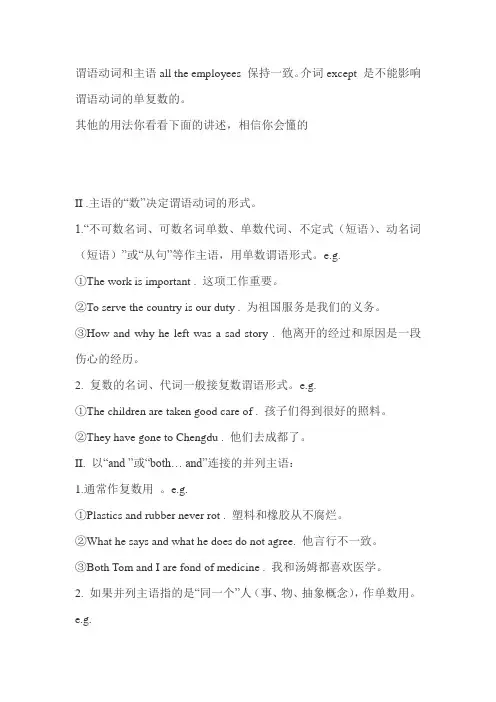
谓语动词和主语all the employees 保持一致。
介词except 是不能影响谓语动词的单复数的。
其他的用法你看看下面的讲述,相信你会懂的II .主语的“数”决定谓语动词的形式。
1.“不可数名词、可数名词单数、单数代词、不定式(短语)、动名词(短语)”或“从句”等作主语,用单数谓语形式。
e.g.①The work is important . 这项工作重要。
②To serve the country is our duty . 为祖国服务是我们的义务。
③How and why he left was a sad story . 他离开的经过和原因是一段伤心的经历。
2. 复数的名词、代词一般接复数谓语形式。
e.g.①The children are taken good care of . 孩子们得到很好的照料。
②They have gone to Chengdu . 他们去成都了。
II. 以“and ”或“both… and”连接的并列主语:1.通常作复数用。
e.g.①Plastics and rubber never rot . 塑料和橡胶从不腐烂。
②What he says and what he does do not agree. 他言行不一致。
③Both Tom and I are fond of medicine . 我和汤姆都喜欢医学。
2. 如果并列主语指的是“同一个”人(事、物、抽象概念),作单数用。
e.g.①The worker and writer has come . 这位工人作家来了。
②A cart and horse was seen in the distance . 远处能看见有一套马车。
③Truth and honesty is the best policy . 真诚是最好的策略。
3. “and”前、后的单数词语都有“each,every ,many ,a ,no”等修饰时,仍作单数用。
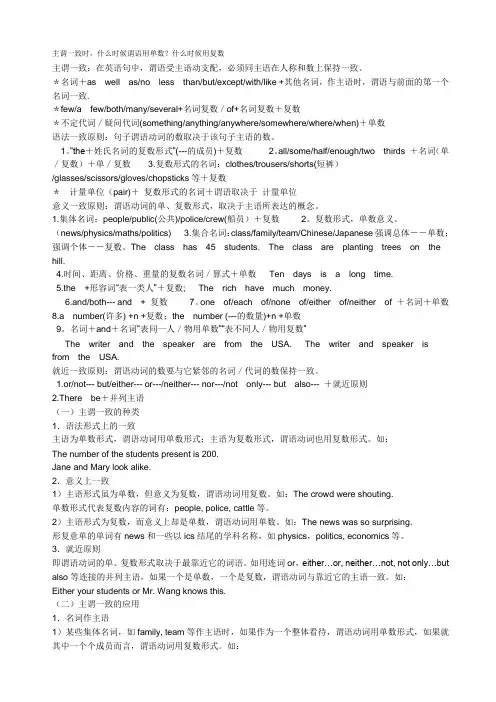
主谓一致时,什么时候谓语用单数?什么时候用复数主谓一致:在英语句中,谓语受主语动支配,必须同主语在人称和数上保持一致。
*名词+as well as/no less than/but/except/with/like +其他名词,作主语时,谓语与前面的第一个名词一致.*few/a few/both/many/several+名词复数/of+名词复数+复数*不定代词/疑问代词(something/anything/anywhere/somewhere/where/when)+单数语法一致原则:句子谓语动词的数取决于该句子主语的数。
1。
“the+姓氏名词的复数形式”(---的成员)+复数2。
all/some/half/enough/two thirds +名词(单/复数)+单/复数 3.复数形式的名词:clothes/trousers/shorts(短裤)/glasses/scissors/gloves/chopsticks等+复数*计量单位(pair)+复数形式的名词+谓语取决于计量单位意义一致原则:谓语动词的单、复数形式,取决于主语所表达的概念。
1.集体名词:people/public(公共)/police/crew(船员)+复数2。
复数形式,单数意义。
(news/physics/maths/politics) 3.集合名词:class/family/team/Chinese/Japanese强调总体--单数;强调个体--复数。
The class has 45 students. The class are planting trees on the hill.4.时间、距离、价格、重量的复数名词/算式+单数Ten days is a long time.5.the +形容词“表一类人”+复数; The rich have much money.6.and/both--- and + 复数7。
one of/each of/none of/either of/neither of +名词+单数8.a number(许多) +n +复数;the number (---的数量)+n +单数9。
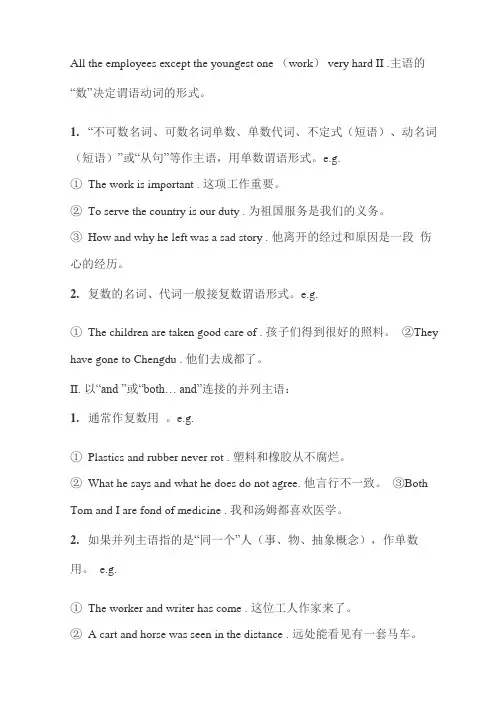
All the employees except the youngest one (work) very hard II .主语的“数”决定谓语动词的形式。
1.“不可数名词、可数名词单数、单数代词、不定式(短语)、动名词(短语)”或“从句”等作主语,用单数谓语形式。
e.g.①The work is important . 这项工作重要。
②To serve the country is our duty . 为祖国服务是我们的义务。
③How and why he left was a sad story . 他离开的经过和原因是一段伤心的经历。
2.复数的名词、代词一般接复数谓语形式。
e.g.①The children are taken good care of . 孩子们得到很好的照料。
②They have gone to Chengdu . 他们去成都了。
II. 以“and ”或“both… and”连接的并列主语:1.通常作复数用。
e.g.①Plastics and rubber never rot . 塑料和橡胶从不腐烂。
②What he says and what he does do not agree. 他言行不一致。
③Both Tom and I are fond of medicine . 我和汤姆都喜欢医学。
2.如果并列主语指的是“同一个”人(事、物、抽象概念),作单数用。
e.g.①The worker and writer has come . 这位工人作家来了。
②A cart and horse was seen in the distance . 远处能看见有一套马车。
③Truth and honesty is the best policy . 真诚是最好的策略。
3.“and”前、后的单数词语都有“each,every ,many ,a ,no”等修饰时,仍作单数用。
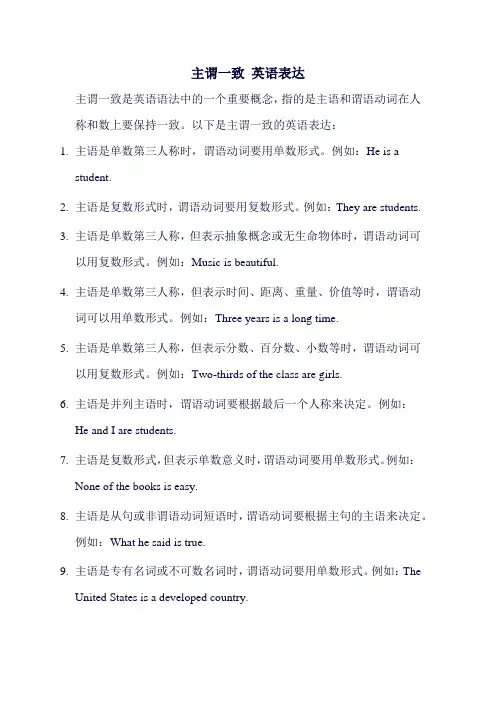
主谓一致英语表达主谓一致是英语语法中的一个重要概念,指的是主语和谓语动词在人称和数上要保持一致。
以下是主谓一致的英语表达:1.主语是单数第三人称时,谓语动词要用单数形式。
例如:He is astudent.2.主语是复数形式时,谓语动词要用复数形式。
例如:They are students.3.主语是单数第三人称,但表示抽象概念或无生命物体时,谓语动词可以用复数形式。
例如:Music is beautiful.4.主语是单数第三人称,但表示时间、距离、重量、价值等时,谓语动词可以用单数形式。
例如:Three years is a long time.5.主语是单数第三人称,但表示分数、百分数、小数等时,谓语动词可以用复数形式。
例如:Two-thirds of the class are girls.6.主语是并列主语时,谓语动词要根据最后一个人称来决定。
例如:He and I are students.7.主语是复数形式,但表示单数意义时,谓语动词要用单数形式。
例如:None of the books is easy.8.主语是从句或非谓语动词短语时,谓语动词要根据主句的主语来决定。
例如:What he said is true.9.主语是专有名词或不可数名词时,谓语动词要用单数形式。
例如:TheUnited States is a developed country.10.主语是集合名词时,谓语动词要根据集合名词的含义来决定。
例如:The team is ready to play.需要注意的是,在实际应用中,需要根据具体情况判断主谓是否一致,并注意避免常见的错误用法。
谓语动词单,复数形式的几种情况1.集合名词police, people等形式上是单数但意义是复数,谓语动词用复数形式。
1).The police ………(be) searching for the thief.2) people all over the world ………..(study) English.2.有些集合名词family, class, team等作主语时,若当整体看,谓语动词用单数形式,若就一个个成员考虑,谓语动词用复数形式。
3) His family ……..(be) a big one. 4) His family ……….(be) waiting for you downstairs.3.以S结尾的名词作主语时一般谓语动词用复数形式,但如果表示学科,时间,金钱,地名,组织时,谓语动词用单数形式。
5) Maths ……..(be) much easier than English,I think.6) Two months……...(be)quite a long time.7) The United Nations………(be) founded in 1945.4.and连接的两个单数名词做主语时,如果意义上是复数,谓语动词通常用复数。
8) Brain and Jenny………(be) in the same class.但是在下列情况谓语动词用单数:1)当连接的两个名词指同一个人或物,或同一概念时,意义上是单数,谓语动词用单数。
9) The teacher and writer………..(be) going to give us a talk tomorrow .2)当连接的两个名词前有every ,each ,no 时,意义上仍是单数,谓语动词用单数形式。
10) Every desk and every chair……….(be) made of wood .5.由并列连词either…or ,neither…nor ,not only…but also 连接两个主语时,谓语动词就近的主语相一致原则。
谓语动词单复数用法 Company number:【WTUT-WT88Y-W8BBGB-BWYTT-19998】谓语动词单复数用法:主谓一致是指:1)语法形式上要一致,即单复数形式与谓语要一致。
2)意义上要一致,即主语意义上的单复数要与谓语的单复数形式一致。
3)就近原则,即谓语动词的单复形式取决于最靠近它的词语,一般来说,不可数名词用动词单数,可数名词复数用动词复数。
There is much water in the thermos.但当不可数名词前有表示数量的复数名词时,谓语动词用复数形式。
Ten thousand tons of coal were produced last year.1 并列结构作主语时谓语用复数Reading and writing are very important.注意:当主语由and连结时,如果它表示一个单一的概念,即指同一人或同一物时,谓语动词用单数,and 此时连接的两个词前只有一个冠词。
The iron and steel industry is very important to our life.2 主谓一致中的靠近原则1)当there be 句型的主语是一系列事物时,谓语应与最邻近的主语保持一致。
There is a pen, a knife and several books on the desk..There are twenty boy-students and twenty-three girl-students in the class.2)当either… or… 与neither… nor,连接两个主语时,谓语动词与最邻近的主语保持一致。
如果句子是由here, there引导,而主语又不止一个时,谓语通常也和最邻近的主语一致。
Either you or she is to go.Here is a pen, a few envelops and some paper for you.3 谓语动词与前面的主语一致当主语后面跟有with, together with, like, except, but, no less than, as well as 等词引起的短语时,谓语动词与前面的主语一致。
名词或代词作主语时和谓语之间的单复数的一致问题1、谓语和谓语基本保持单复数的一致,即:主语是可数名词单数或不可数名词时,谓语动词用单数形式:如:The computerwas a great invention.(计算机是个了不起的发明)The water in the glass is very cold.(玻璃杯里的水很冷)2、集体名词(如family, class, team, group, row, police, school等)做句子主语时,①如果表示整体概念,则谓语用单数形式,如:Class Three is a very good class.(三班是好班)②如果表示其中的所有成员时,则谓语用复数形式,如:Class Threehave a map of China.(三班有张中国地图)3、Chinese, Japanese, fish, sheep, people等表示单个时谓语用单数,表示许多时,谓语用复数。
如:Thereis a sheep in the yard.(院子里有只绵羊)/ There are some sheep in the yard.(院子里有一些绵羊)4、maths, news等虽然有s结尾,但不是复数,因此谓语仍用单数:The newsis very exciting.(这个消息令人兴奋)5、glasses, shoes, socks, trousers, gloves等名词往往用复数形式,故谓语用复数。
如:The trousers are very cheap and I want to take them.(裤子很便宜,我想买)6、a lot of后跟名词复数时谓语用复数形式,跟不可数名词时谓语用单数形式。
如:A lot of students are playing baseball now.(现在有许多学生在打垒球) A lot of time was wasted on that work.(大量的时间花在了那个工作上)(被动句)7、and连接两个名词做主语时,谓语原则上用复数,但是两个名词若构成一个整体事物时,谓语则用单数。
谓语动词单复数谓语动词单复数是英语学习中的重要知识,尤其是面对中高级水平的学习者,更是需要充分掌握的一项基本功。
要正确使用谓语动词的单复数,需要学习者熟练掌握动词本身的单复数形式变化,也要充分了解它们的特定用法。
谓语动词单复数的形式变化主要有三种:即 -s/-es,-ies 以及不变形式。
-s / -es变化是最常见的,如:run----runs;watch----watches。
-ies变化主要用于以-y尾结尾的动词,如:try----tries;study----studies。
而有些动词表示状态以及感受的动词,它们在单复数形式上不发生变化,如:sleep----sleeps;seem----seems。
此外,还有一些特殊的动词,它们的单复数形式有所变化,但并不一定需要加-s -es。
这些动词主要指及“改变”、“发出声音”、“捕捉”等情况,如:set----set;sweep----sweep;catch----catch。
有的还可以在口语中发生变化,如:cut----cut/cuts;put----put/puts。
另外,谓语动词有时会受到谓语的其他时态形式的影响,形成“谓语动词单复数双重变化”。
这种双重变化一般出现在主语是第三人称单数的句子中,如:She goes----They go。
有时双重变化伴随着情态动词,这时谓语的变化全部依赖于情态动词的变化,如:He must go----They must go。
在掌握了谓语动词单复数形式变化的基础上,学习者还需要了解它们的特定用法。
有的动词可以在口语中普遍采用单复数形式变化,但在书面语中往往会根据句子的结构和意思来使用单复数形式。
例如,用在宾语从句中的动词会保持单数,如:He says he is happy。
另外,有些被动句中的动词会保持不变,如:He was asked to leave。
以上就是谓语动词单复数的基本内容,虽然不难,但是学习者仍需要全面的掌握,才能运用自如而正确的表达。
高一语法---主谓一致主谓一致是指主语与谓语在数上要一致。
一.谓语动词用单数的情况1.动名词短语、不定式短语、名词性从句做主语,谓语用单数。
如:Buying clothes is often a time-consuming job.To understand the situation completely requires more thought.2.表示时间、距离、金额、重量、面积、体积、容积等度量的名词短语做主语时,谓语用单数。
Two weeks was too long. Ten yuan is enough.十元钱足够了。
3.一般用and连接的两个单词或短语做主语时候,谓语用复数,但是下面用and连接的主语表示一个概念,谓语用单数:law and order 法制soap and water 肥皂水a cup and saucer 茶杯碟子fork and knife 刀叉the needle and thread 针线trial and error 反复尝试,不断摸索horse and carriage 马车time and tide 岁月bread and butter 奶油面包the ebb and flow 盛衰,潮涨潮落Bread and butter is our daily food Time and tide waits for no man4. 代词each和由every, some, no, any等构成的复合代词作主语,或主语中含有each, every, 谓语需用单数。
例如:Each of us has a tape-recorder.我们每个人都有一台录音机。
There is something wrong with my watch.我的表出问题了。
5. 两个用and连接的单数可数名词作主语,且第二个名词前无冠词,表示“一体”或“一双”,谓语动词用单数。
谓语动词用单数的情况
1.动名词短语、不定式短语、名词性从句做主语,谓语用单数。
如: Buying clothes is often a time-consuming job because those clothes that a person likes are rarely the cones that fit him or her. (1987年考研题) To understand the situation completely requires more thought than has been given thus far.
2.表示时间、距离、金额、重量、面积、体积、容积等度量的名词短语做主语时,谓语用单数。
Two weeks was too long Five times five makes twenty five 3.一般用and连接的两个单词或短语做主语时候,谓语用复数,但是下面用and连接的主语表示一个概念,谓语用单数: law and order 法制 soap and water 肥皂水 a cup and saucer 茶杯碟子 fork and knife 刀叉 the needle and thread 针线 trial and error 反复尝试,不断摸索 horse and carriage 马车 time and tide 岁月 bread and butter 奶油面包 the ebb and flow 盛衰,潮涨潮落如: If law and order not preserved, neither the citizen nor his property is safe. A. is B. are C. was d. were 答案:A。
4.表示学科和某些疾病名称的名词是复数形式,作主语时候谓语动词用单数形式 Linguistics is a branch of study on human language.
5.有些名词形式上是复数,意义上是单数,根据意义一致原则动词用单数 The chaos was stopped by the police The news is a great encouragement to us A series of debates between the lectures was scheduled for the next weekend.
6.用and 连接的成份表示一个单一概念时候,动词谓语用单数形式 Bread and butter is our daily food Time and tide waits for no man《和3同》
二.谓语用复数情况
1.由and, both …and, 连接的并列主语,和both ,a few, many ,several 等修饰语后面谓语动词通常用复数形式。
Few people know he and I were classmates when we were at college.
2.集体名词police, public, militia, cattle ,class ,youth后常用复数形式的动词 The Chinese people are brave and hardworking The cattle are grazing in the sunshine
3.当表示民族的词与冠词合用当主语,谓语动词用复数形式 The Japanese were once very aggressive
4.某些形容词前面加定冠词表示一类人,做主语时候,谓语动词用复数 The rich are not always selfish
5.不可数名词作主语,其前有表示数量的复数名词修饰时,谓语动词用复数 Three million tons of coal were exported that year
三.谓语动词可用单数,也可以用复数的情况
1.就近一致原则这种情况下,谓语动词使用单数还是复数取决于最靠近该动词的主语的单复数,存在这种情况的主要由以下几种可能:
1)由连词either…or…; neither…nor…; whether… or…;not only…but
(also) ;or 等连接的并列主语 Neither money nor fame has influence on me Not only you but also he is wrong
2) 在倒装结构中,谓语动词与后面的第一个主语一致 Blocking the open-sided porch, framed by the enveloping fog, stands a tall grave-faced policeman. Just outside the ruins is a magnificent building surrounded by tall trees. Although a great number of houses in that area are still in need of repair, there has been improvement in the facili
2.主语带有(together/along)with, such as, accompanied by, as well as, no less than, except, besides, with, combined with, in addition to , including, together with 等等附加成分,谓语的数不受附加成分的影响仍然与主语保持一致Professor Taylor , with six of his students ,is attending a conference in Boston organized to compare current practice in the United States with those of other nations. The president of the college, together with the deans, is planning a conference for the purpose of laying down certain regulations. (1981年考研题) 3.关系代词做主语的定语从句中,谓语的数要与先行词一致。
如: Despite much research, there are still certain elements in the life cycle of the insect that are not fully understood. (1996年考研题) There are many valuable services which the public are willing to pay for, but which do not bring a return in money to the community. (1990年考研题)
4.一些表示数量的短语与名词连用时候,谓语动词的数取决于名词的数,名词是复数,谓语动词用复数,反之就用单数。
这些短语包括:a lot of /lots of; plenty of/heaps of; half of; two-third (three-fourth…) of; eighty(ten, twenty…) percent; part of; rest of ; none of 等等 Two-thirds of people present are women Lots of damage was caused by the fire
5.集体名词作主语时,谓语动词的数取决于主语表示的意思和数,当表示整体时候,谓语动词就用单数,当强调集体中的个体时候,谓语动词就用复数。
这些集体名词如:army, audience, band ,government ,group ,flock, police,
public ,staff ,team ,troop. Crowd, firm, family 等等 The family is the basic unit of our society The family were watching the TV The audience was enormous The audience were greatly moved at the words
6.某些固定结构中主语与谓语的数:
第一组: a great many + 可数名词复数谓语用复数 a number of + 可数名词复数谓语用复数 the majority of + 可数名词复数谓语用复数
第二组; the number of + 可数名词复数谓语用单数 each/every + 可数名词复数谓语用单数 neither/either of + 可数名词复数谓语用单数 one and a half + 可数名词复数谓语用单数
第三组; more than one + 可数名词单数谓语用单数 many a + 可数名词单数谓语用单数
第四组; the greater part of a large proportion of 50% of one third of plenty of the rest of 谓语的数与of 后面的名词一致
第五组;(n)either…(n)or…. not only….. but also ……
not …..but …… 谓语的数与主语的第二部分(即(n)or/ but also/ but引导的后面部分)一致.
注意比较: More students than one have been referred to。